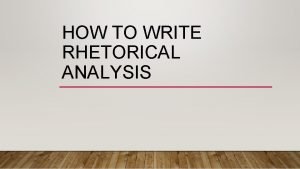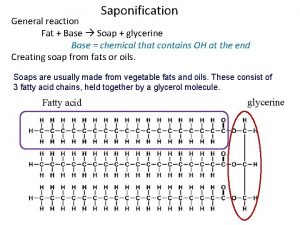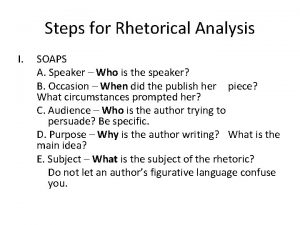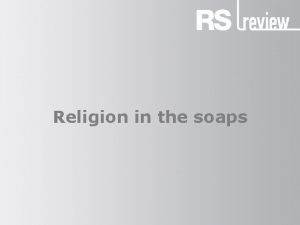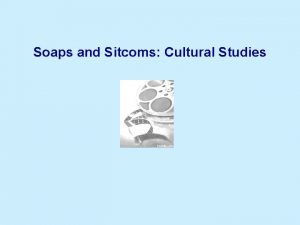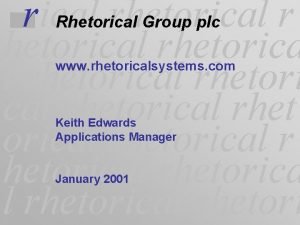Steps for Rhetorical Analysis I SOAPS A Speaker






- Slides: 6

Steps for Rhetorical Analysis I. SOAPS A. Speaker – Who is the speaker? B. Occasion – When did the publish her piece? What circumstances prompted her? C. Audience – Who is the author trying to persuade? Be specific. D. Purpose – Why is the author writing? What is the main idea? E. Subject – What is the subject of the rhetoric? Do not let an author’s figurative language confuse you.

Steps for Rhetorical Analysis II. Appeals and Balance A. Appeals to logic (Logos) i. the subject B. Appeals to character (Ethos) ii. the speaker C. Appeals to emotion (Pathos) iii. the audience Relevant Questions: Is the author’s rhetoric properly balanced? Is there an over emphasis on one element? If there is a strong emphasis on one element is it justified?

Steps for Rhetorical Analysis III. The Argument A. Type of Claims i. Claims of Fact ii. Claims of Cause iii. Claims of Definition iv. Claims of Value v. Claims of Policy B. Thesis Statements i. Closed Thesis ii. Implied Thesis iii. Counter-Argument Thesis C. Evidence i. First Hand Evidence a. Anecdote – Personal Experience b. Current Events ii. Second Hand Evidence a. Historical Information b. Expert Opinion c. Quantitative Evidence iii. Logical Fallacies a. Fallacies of Relevance i. Red Herring ii. Ad hominem iii. Faulty analogy iv. Appeals to false authority v. Bandwagon Appeal b. Fallacies of Accuracy i. straw man fallacy ii. False dilemma iii. Post Hoc Ergo Propter Hoc c. Fallacies of Insufficiency i. Hasty generalization ii. Begging the Question (Circular Reasoning)

Steps for Rhetorical Analysis IV. Organization & Structure – How is the rhetoric organized? A. Chronological – Narrative B. Enumeration – Numbering/Steps C. Problem/Solution D. Cause and Effect E. Exemplification – Using specific examples F. Spatial – Visual G. Classification – Topical H. Jeremiad – Ideals, Failings, Hope I. Etc…. Relevant Questions: How has the author organized her entire text? How has she organized a paragraph? Why did she choose a specific organizational strategy?

Steps for Rhetorical Analysis V Style A. Diction – Word Choice i. Types of diction ii. Changes in diction iii. Absolutes vs. Qualifiers B. Syntax – Sentence Structure i. Simple, Compound, Complex Sentences ii. Periodic or Loose Sentences iii. Passive vs. Active Voice iv. Use of subordination and coordination v. Parallelism, Antithesis, Anaphora, Epistrophe C. Tone – The Attitude of the Speaker i. Types of tone ii. Shifts in tone iii. Verbal Irony: Meaning the opposite of what’s said presuming that the audience will catch on. Relevant Questions: Why does an author use a specific word? Sentence structure? How do the diction and syntax contribute to the tone? Is the author being serious?

Steps for Rhetorical Analysis VI. Figurative Language A. Metaphor, Simile, and Analogy i. Extended vs. Simple ii. Don’t take them literally B. Personification and Apostrophe C. Metonymy and Synecdoche D. Hyperbole and Understatement E. Paradox F. Allusions (If it’s American Lit. and you don’t recognize it, it’s probably in the Bible) G. Etc… Relevant Questions: Is the author speaking literally or figuratively? What allusions might the author be making? What is the dominant literary device and what is its rhetorical effect?

